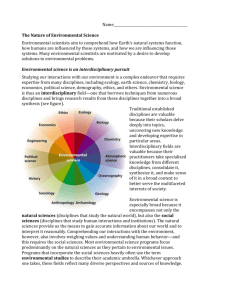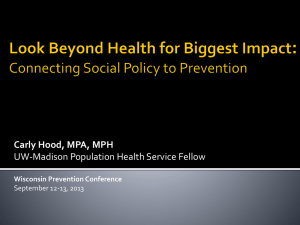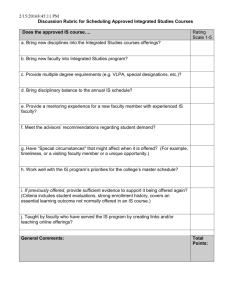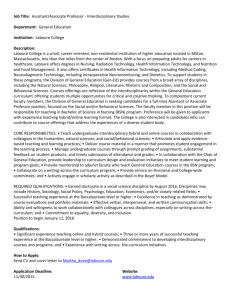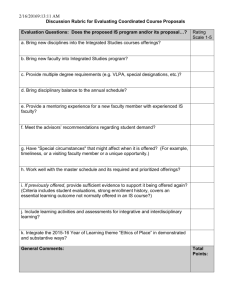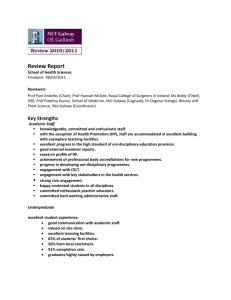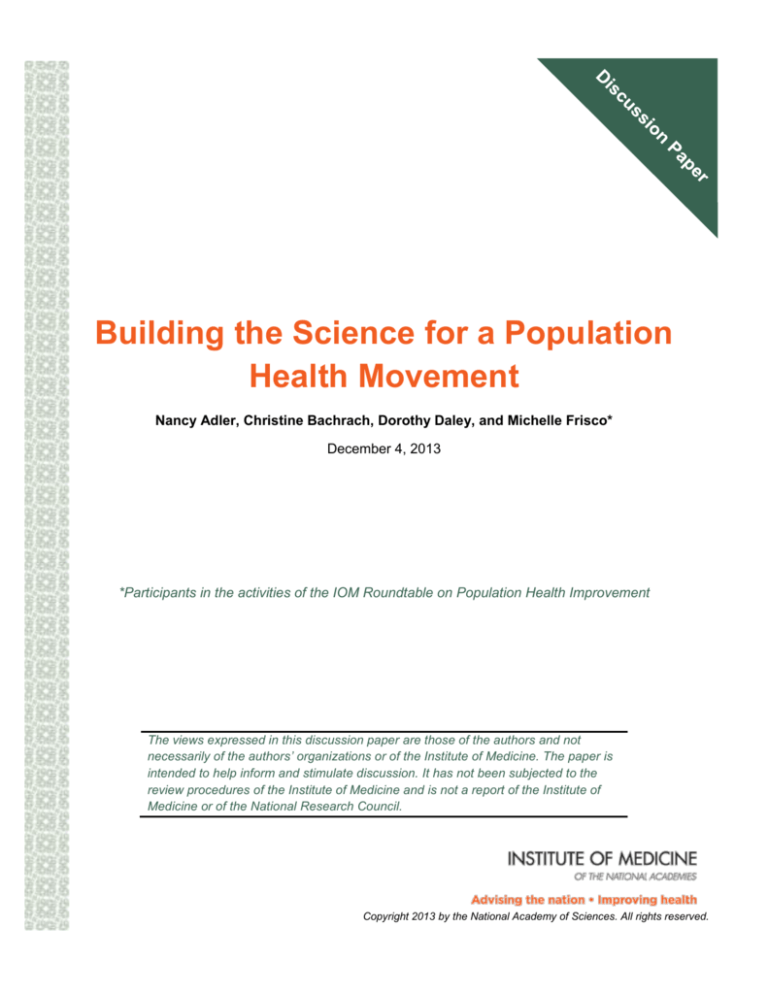
Building the Science for a Population
Health Movement
Nancy Adler, Christine Bachrach, Dorothy Daley, and Michelle Frisco*
December 4, 2013
*Participants in the activities of the IOM Roundtable on Population Health Improvement
The views expressed in this discussion paper are those of the authors and not
necessarily of the authors’ organizations or of the Institute of Medicine. The paper is
intended to help inform and stimulate discussion. It has not been subjected to the
review procedures of the Institute of Medicine and is not a report of the Institute of
Medicine or of the National Research Council.
Copyright 2013 by the National Academy of Sciences. All rights reserved.
Building the Science for a Population Health Movement
Nancy Adler, University of California, San Francisco;
Christine Bachrach, University of Maryland; Dorothy Daley, University of Kansas;
and Michelle Frisco, The Pennsylvania State University1
A movement for population health starts with a basic understanding that health is
determined by far more than health care and that the focus of health investments must go beyond
health care alone. It follows that we need to invest in healthy environments, in efforts to ameliorate
social and economic disparities and their impacts on health, and in creating a positive “culture of
health” that both recognizes and encourages health-promoting action on the part of individuals and
institutions.2 A corollary of the population health movement is that health policy cannot be limited
to health care policy. Instead, what is needed is a rallying call for “health in all policies.”
Although the central tenet of population health and its policy-related corollary have gained
some traction, there are a number of challenges to institutionalizing these. The framing of the quest
to do so as a “movement” rather than a “paradigm change” acknowledges the political as well as
intellectual components of population health. Some of the challenges to establishing population
health derive from political and social concerns, while others derive from intellectual and scientific
ones. In this discussion paper, we consider how the growing field of population health research can
contribute to the movement for population health action. We argue that a population health
movement will be most effective if it integrates both research and action and finds new ways to
ensure that each informs the other.
WHAT IS POPULATION HEALTH RESEARCH?
Kindig and Stoddart (2003) define population health as “the health outcomes of a group of
individuals, including the distribution of such outcomes within the group.” Population health
research has evolved to include a broad range of disciplines, scientific methods, and theories that
contribute to understanding the mechanisms through which these outcomes and their distributions
can be understood and improved. Most descriptions of the field include one or more of the
following characterizations3:
Population health research is interdisciplinary and focuses on the health outcomes of groups
of individuals, which can be defined in multiple ways (e.g., workers at a workplace,
residents of a neighborhood, people sharing a common race or social status, or the
population of a nation).
Population health researchers conduct studies that seek to characterize, explain, and/or
influence the levels and distributions of health within and across populations.
Population health researchers view health as the product of multiple determinants at the
biologic, genetic, behavioral, social, and environmental levels and their interactions among
individuals, communities, time, and place.
1
Participants in the activities of the IOM Roundtable on Population Health Improvement.
See the Robert Wood Johnson Foundation’s (RWJF’s) Culture of Health blog.
3
See “What Is Population Health Research?,” RWJF Health and Society Scholars .
2
1
The field addresses health outcomes, health determinants, and policies and interventions that
link the two in efforts to improve population health and ameliorate health disparities.
Population health research addresses a diverse set of outcomes. Some are risk factors for reduced
population health, such as biological markers of physiological functioning, health-related behaviors,
and specific diseases. Other important outcomes are global indicators of health, such as overall
well-being, healthy life expectancy, and mortality.
HALLMARKS OF THE FIELD
The “field” of population health is defined less by its boundaries than by its core purpose—
to develop answers to complex questions about the drivers of health in a population. The
foundations of population health research are found in many disciplines. For example, the study of
population mortality trends and differentials has always been a core feature of demography, and that
of disease incidence and prevalence at the population level a core feature of epidemiology. One of
the hallmarks of the field is its attention to the social causes of disease and health, an insight
pioneered by early scholars from Quetelet to Durkheim, institutionalized in the field of social
epidemiology (Berkman and Kawachi 2000), and, increasingly, examined in other fields that
historically have had minimal interest in health as an outcome. Social and behavioral scientists of
all stripes have now joined in the study of the determinants of health. Sociologists bring the study of
institutions, stratification, discrimination, social networks, and the life course to bear on health
outcomes; anthropologists bring the study of culture and practice; economists bring research on
micro-level forces shaping individual actions and health outcomes and macro-level conditions
shaping national investment and health outcomes; political scientists bring analysis of formal and
informal decision-making processes that lead to health policy; historians bring the evolution of our
health systems; and psychologists bring the cognitive, affective, and behavioral mediators of social
environments on health. Among others, geographers, ecologists, environmental scientists, urban
planners, health professionals, geneticists, and neuroscientists also contribute to answering
questions about population health.
The major advance in population health research has been to integrate the contributions of
these fields to build a multilevel understanding of health, from cells to society. This includes not
only the “upstream” causes of health (from the social to the physical and chemical environment) but
also the behavioral and biological pathways that link these to population health. Population health
scientists typically begin with a complex problem and then assemble the disciplines and
perspectives needed to provide a full understanding. Such efforts have already been made in the
area of tobacco use and smoking through programs such as the Transdisciplinary Tobacco Use
Research Centers at eight U.S. universities. These centers, funded by multiple National Institutes of
Health (NIH) agencies and the Robert Wood Johnson Foundation (RWJF), were motivated by the
recognition that it would take scientists from multiple backgrounds working together and
recognizing the contributions of those outside their field to solve the nation’s tobacco issues.
Similar efforts will be necessary to tackle the obesity epidemic and improve population health more
generally.
2
MANY CONTRIBUTIONS TO DATE
Population health research has already contributed substantially to the population health
movement. It has provided the foundation for reports such as RWJF’s Commission to Build a
Healthier America, the report of the World Health Organization’s Commission on the Social
Determinants of Health, Closing the Gap in a Generation, and many recent reports from the
National Academy of Sciences.4 It has provided the basis for ratings systems such as the County
Health Rankings & Roadmaps project. Evidence documenting the importance of upstream
determinants of health has motivated key institutions to adopt multisectoral approaches to
improving population health; examples include RWJF’s programs on obesity, The California
Endowment’s “Building Healthy Communities” commitment, the Federal Reserve Bank’s initiative
on healthy communities, the Centers for Disease Control and Prevention’s Health Community
Design Initiative, and the Obama administration’s place-based initiatives. Although the National
Institutes of Health remains primarily focused on finding cures for disease, many of its components
have also adopted programs directed at multisectoral, upstream interventions to improve health.5
The Health in All Policies initiative of the National Association of County and City Health
Officials is also grounded in population health research. Health impact assessment necessarily
draws on the tools and findings of population health scientists, both to recognize what policies can
potentially impact health and to design studies that can rigorously identify policy impacts.
Population health researchers’ work relating early childhood experience to later health provides an
example. Investments in early childhood education are not intuitively health-related, yet population
health researchers have begun to tease out the social, economic, and biological pathways that link
the early development of cognitive and non-cognitive skills to later health.
WHAT ARE THE MOST PRESSING QUESTIONS IN POPULATION HEALTH?
Despite widespread efforts to address the upstream causes of poor health, the imbalance in
health investment in the United States has not been fundamentally altered. We still invest
disproportionately in curing and managing diseases that could have been prevented with
investments in prevention and population health. Achieving the goal of maximizing population
health depends not only on convincing the public and policy makers to do the right thing, but also
on providing data to guide choices about the most effective levers for improving population health,
demonstrating the return on investment for manipulating them, specifying the conditions under
which they are most effective, and identifying the mechanisms producing their effects. We believe
that existing research provides a sound basis for moving forward to improve population health in
many areas. However, we also believe that research and action must go hand in hand to solidify the
evidence base and achieve maximal impact. The public and policy makers have experienced the
failure of “commonly accepted scientific knowledge” and “programs we know will work” too many
times to proceed without undertaking new research. Moving forward on the basis of existing
knowledge will produce successes and failures; integrating action and research will uncover new
knowledge that pushes us toward greater success.
One of the clearest findings in population health research is the ubiquitous nature of
socioeconomic disparities in health, but we lack a rigorous understanding of the mechanisms
4
Recent examples include IOM (2012a,b); IOM and NRC (2013); and NRC (2009).
For examples, see the National Heart, Lung, and Blood Institute–led Healthy Communities Study and the National
Cancer Institute–led program of Research on Population Health and Health Disparities.
5
3
involved in producing these. We still cannot explain with confidence how social and economic
disadvantage “gets under the skin” to affect health outcomes. This makes the process of
ameliorating disparities dependent on one’s favorite hypothesis, or, on the other hand, makes it easy
for nonbelievers to dismiss as fantasy the prospect of improving health by eliminating social and
economic disadvantage. The turn in population health research from documenting disparities to
understanding the causal pathways creating them is relatively recent (Adler and Stewart, 2010).
There is still much work to be done to identify the pathways that are responsive to effective
intervention.
A different problem exists in the realm of environmental exposures, be they chemical toxins,
neighborhood crime, or food deserts. The language of “exposure,” adopted from epidemiology and
environmental science, discounts the very important role of human and institutional agency in
creating the environments we are exposed to and in shaping the choices people make about where to
live and how to behave. We have come only so far in learning how to isolate the effects of a single
aspect of the environment from the multiple confounding effects of the social system in which it is
embedded.6 We have also made limited progress in capturing complex sets of exposures over time
and place. Recent efforts are under way at the Environmental Protection Agency to support research
on cumulative risk assessment methods that integrate social and behavioral information with
toxicity and exposure data to better understand how multiple environmental hazards affect the
health of individuals in a community. This type of decision-making tool is in its infancy, and
significant challenges lie ahead, including the sheer volume of information needed to conduct this
type of assessment and the complexities of interpreting and integrating disparate information (Lewis
et al 2011).
Changing patterns of population health also pose new questions. For example, we have few
explanations for the alarming finding that mortality is increasing for those lacking a high school
degree, especially among white women (Kindig and Cheng, 2013; Montez and ZaJacova, 2013;
Olshansky et al., 2012). Finding out why this is happening is a critical question for population
health, but we do not understand the relevant mechanisms.
Research will also be needed to facilitate ambitious goals, such as RWJF’s laudable
proposal to create a new “culture of health.” Such an initiative requires modifying or replacing our
existing, medicine-dominated culture of health. Immersion in the current culture makes it more
challenging to introduce a new one. Social movements research can help to overcome this
difficulty, as can research on our current culture, its distribution across space and groups, its
evolution over time, and the relation of its key elements to health behaviors, use of medical
services, and public investments.
A RAPIDLY EXPANDING FIELD
The field of population health is growing fast. This growth is evident in the many schools of
medicine and public health that have established departments with a population health focus; the
establishment of new interdisciplinary disciplines, such as social epidemiology and population
neuroscience (Falk et al., 2013); the movement of disciplinary scholars into interdisciplinary
departments focused on health; the expansion of social science surveys to include markers of health
and disease; and the growth, within disciplinary journals, of population health content. In the two
6
For example, little research that measures the effect of built and chemical environments adequately takes into account
the mobility processes that lead people to live in the environments under study or the processes through which
community residents shape their exposures.
4
decades between 1970 and 1989, less than 1 percent of articles published in the flagship journals of
demography and sociology were about health; since 2000, 31 and 10 percent, respectively, have
focused on health.7 Special features about the contributions of social science to understanding gene–
environment interactions have appeared in the American Journal of Sociology (2008) and the
American Journal of Public Health (2013).
This growth has occurred for many reasons: increasing awareness of the economic costs of
our population’s poor health and the need for population health action, the lure of research funding
from NIH, the promotion of interdisciplinary science by NIH and other science funders, and the fact
that the field offers a wealth of important and novel challenges that have real import for society.
RWJF has been a major force in the growth of the field, largely through its Health and Society
Scholars program. The foundation launched this program more than a decade ago to equip scientists
with the skills for tackling such complex interdisciplinary questions. So far, the program has
graduated 157 scholars, who now hold positions in research, policy, and the private sector in
institutions all over the United States. Alumni of the program are enriching existing fields of study
with new questions, new methods, and interdisciplinary perspectives; training new population
health scholars; and recruiting many disciplinary scientists into population health research. They are
also promoting an enhanced vision for how academic research can have an impact on health via
dissemination, policy, and practice—as well as a vision for the types of questions that need to be
answered more effectively in the service of a population health movement.8
MEETING CHALLENGES
New interdisciplinary fields rarely grow without facing serious challenges, and the field of
population health research is no exception. One lingering challenge for the field is the lack of
consensus on a clear definition.9 Because the field is defined less by boundaries than by goals and
the field encompasses everything that affects health, it sometimes seems to beg the question, What
is not population health? Also, the term “population health” has been used in diverse ways by
different communities. The medical community typically uses it to signify a group of patients to
whom they are delivering care; others, including the authors of this paper, use it to refer to the
health status of whole communities or nations. These differences need to be bridged and clarified.10
Challenges also result from the nature of traditional academic structures. The production and
dissemination of knowledge tends to be the domain of well-established disciplines. Fragmented
knowledge housed in many different disciplinary homes creates challenges for widespread
knowledge accumulation and application in population health. Applied research is often disparaged
in disciplines with a basic focus. Science in areas of inquiry that bridge disciplines tends to face
systematic challenges in getting published because most peer-reviewed journals reflect disciplinary
boundaries. As the number and prestige of diverse, interdisciplinary publication outlets grows,
population health science will also expand. But disciplinary departmentalization in higher education
7
Authors’ own calculations based on a search of Web of Science.
A few examples of work by alumni of the program include economic analysis of the impact of taxes on sugary sodas
(Fletcher et al., 2010), working to integrate analysis of health impacts in community development (Jutte et al., 2011),
and development of a private firm providing technologies for tracking asthma attacks in time and space (van Sickle et
al., 2013).
9
This is not unusual. In his classic textbook on social psychology, Roger Brown (1965) critiqued the existing
definitions of the field (e.g., the linkage between psychology and sociology) and finally defined it as “that set of
activities that people who call themselves Social Psychologist do.”
10
See Kindig (2012) on the difference between population health and population medicine.
8
5
remains. A population health research movement must pursue a dual strategy that works both within
existing disciplines that have new insights necessary for improving population health and outside
disciplines to create new professional spaces that link researchers in productive ways and allow
them to study persistent population health challenges.
Challenges also accompany the way population health research is funded. Just as the
structure of academic institutions is siloed by disciplinary departments, the structure of the major
funder of health research, NIH, is siloed by disease type. There are a few cross-cutting units, such as
the Office of Behavioral and Social Sciences Research, the National Institute on Aging, and the
Institute for Minority Health and Health Disparities, but these control a small share of NIH
resources. At a time of flat or diminishing funding, the lack of support is particularly worrisome.
HOW CAN POPULATION HEALTH RESEARCH
ADVANCE POPULATION HEALTH ACTION?
We argue above that research and action must go hand in hand in the movement for
population health. Although there are undeniably many challenges in making this happen, there are
exciting opportunities as well.
The biggest challenge is to develop better bridges between basic and applied research and
among researchers, policy makers, and practitioners. In a society increasingly skeptical of experts
and expert knowledge,11 it is critically important to develop agile institutional mechanisms that link
population health science and practice. As the evidence base grows and as research results suggest
explanations that have practical applications, it will be important to establish clear processes that
can capitalize on this evidence. Similarly, when research results are put into practice, it will be
important for organizations to have sufficient resources to evaluate the integration of this research
in an applied setting and to have a process to inform population health researchers about the
application. This type of interdependent relationship, if done well, can create an innovative learning
environment that is mutually beneficial—an environment in which corrective actions based on the
emergence of new scientific evidence build public trust, rather than corrode it.
New developments in research and practice may facilitate such bridges. The evolution of
electronic medical records, electronic sensing devices, and technologies for capturing everyday
social and economic transactions are now making possible the development of continuously
operating integrated population data platforms that link timely information on the environmental,
policy, socioeconomic, behavioral, and health system factors that interact to produce health
outcomes for a community. Such “big data” platforms are already being developed in communities
across the country and provide a nexus for linking research and practice (Barrett et al., 2013). With
appropriate privacy protections, these new data systems will provide an unprecedented resource for
systems approaches to understanding how the multiple determinants of population health interact.
They will also be a critical resource for health impact assessment and the evaluation of population
health interventions. This work would be facilitated by agreement within the field about the best
metrics for assessing overall population health.
Research alone will not produce the change that we all seek in the nation’s health
investments and health outcomes. Much scholarship demonstrates that “evidence” is a marginal
factor in public decision making, yet, over time, as accumulated evidence affects public awareness
and credibility, policy makers heed it. A population health movement built around sound strategies
to change the nation’s culture of health will facilitate this process. Putting in place an effective
11
The movement to resist vaccination programs is an example.
6
partnership between research and action—a mutually interdependent system that is continuously
updated—will help to ensure that the movement achieves substantial and lasting improvements to
the nation’s health.
REFERENCES
Adler, N. E., and J. Stewart. 2010. Health disparities across the lifespan: Meaning, methods, and mechanisms. Annals
of the New York Academy of Sciences 1186:5-23.
Barrett, M.A, O. Humblet ,R. Hiatt, and N. E. Adler. 2013. Big data and disease prevention: From quantified self to
quantified communities. Big Data 1(3):168-175.
Berkman, L., and I. Kawachi (Eds.) 2000. Social Epidemiology. New York: Oxford University Press.
Brown, R. 1965. Social Psychology. New York: Free Press.
Falk, E. B., L. W. Hyde, C. Mitchell, J. Faul, R. Gonzalez, M. M. Heitzegi, D. P. Keating, K. M. Langae, M. E. Martz,
J. Maslowsky, F. J. Morrison, D. C. Noll, M. E. Patrick, F. T. Pfeffer, P. A. Reuter-Lorenz, M. E. Thomason,
P. Davis-Kean, C. S. Monk, and J. Schulenberg. 2013. What is a representative brain? Neuroscience meets
population science. Proceedings of the National Academy of Sciences 110( 44):17615-17622.
Fletcher, J., D. Frisvold, and N. Tefft. 2010. The effects of soft drink taxation on soft drink consumption and weight for
children and adolescents. Journal of Public Economics 94(11-12):967-974.
IOM (Institute of Medicine). 2012a. For the public’s health: Investing in a healthier future. Washington, DC: The
National Academies Press.
IOM. 2012b. An integrated framework for assessing the value of community-based prevention. Washington, DC: The
National Academies Press.
Jutte, D. P., K. Z. LeWinn, M. A. Hutson, R. Dare, and J. Falk. 2011. Bringing researchers and community developers
together to revitalize a public housing project and improve health. Health Affairs 30(11):2072-2078.
Kindig, D. 2012. Is population medicine population health? Improving population health: Policy, practice, research.
http://www.improvingpopulationhealth.org/blog/2012/06/is-population-medicine-population-health.html
(accessed November 14, 2013).
Kindig, D. A., and E. R. Cheng. 2013. Even as mortality fell in most US counties, female mortality nonetheless rose in
42.8 percent of counties from 1992 to 2006. Health Affairs 32(3):451-458.
Kindig, D. A., and G. Stoddart. 2003. What is population health? American Journal of Public Health 93:380-383.
Lewis, A. S., S. N. Sax, S. C. Wason, and S. L. Campleman. 2011. Non-chemical stressors and cumulative risk
assessment: An overview of current initiatives and potential air pollutant interactions. International Journal of
Environmental Research and Public Health 8(6):2020-2073.
Montez, J. K., and A. Zajacova. 2013. Explaining the widening education gap in mortality risk among U.S. white
women. Journal of Health and Social Behavior 54(2):165-181.
NRC (National Research Council). 2009. Science and decisions: Advancing risk assessment. Washington, DC: The
National Academies Press.
NRC and IOM. 2013. U.S. health in international perspective: Shorter lives, poorer health. Washington, DC: The
National Academies Press.
Olshansky, S. J., T. Antonucci, L. Berkman, R. H. Binstock, A. Boersch-Supan, J. T. Cacioppo, B. A. Carnes, L. L.
Carstensen, L. P. Fried, D. P. Goldman, J. Jackson, M. Kohli, J. Rother, Y. Zheng, and J. Rowe. 2012.
Differences in life expectancy due to race and educational differences are widening, and many may not catch
up. Health Affairs 31:1803-1813.
Van Sickle, D., S. Magzamen, S. Truelove, and T. Morrison. 2013. Remote monitoring of inhaled bronchodilator use
and weekly feedback about asthma management: An open-group, short-term pilot study of the impact on
asthma control. PLoS One 8(2):e55335. doi: 10.1371/journal.pone.0055335.
Suggested citation: Adler, N., C. Bachrach, D. Daley, and M. Frisco. Building the science for a population health
movement. Discussion Paper, Institute of Medicine, Washington, DC.
http://www.iom.edu/Global/Perspectives/2013/BuildingTheScience.
7

